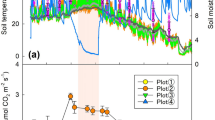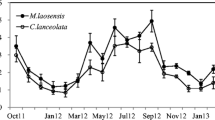Abstract
The seasonal dynamics of soil respiration in steppe (S. bungeana), desert shrub (A. ordosica), and shrubperennial (A. ordosica + C. komarovii) communities were investigated during the growth season (May to October) in 2006; their environmental driving factors were also analyzed. In the three communities, soil respiration showed similar characteristics in their growth seasons, with peak respiration values in July and August owing to suitable temperature and soil moisture conditions during this period. Meanwhile, changes in soil respiration were greatly influenced by temperatures and surface soil moistures. Soil water content at a depth of 0 to 10 cm was identified as the key environmental factor affecting the variation in soil respiration in the steppe. In contrast, in desert shrub and shrub-perennial communities, the dynamics of soil respiration was significantly influenced by air temperature. Similarly, the various responses of soil respiration to environmental factors may be attributed to the different soil textures and distribution patterns of plant roots. In desert ecosystems, precipitation results in soil respiration pulses. Soil carbon dioxide (CO2) effluxes greatly increased after rainfall rewetting in all of the ecosystems under study. However, the precipitation pulse effect differed across the ecosystem. We propose that this may be a result of a reverse effect from the soil texture.
Similar content being viewed by others
References
Amundson, R., 2001: The carbon budget in soils. Annual Review of Earth and Planetary Sciences, 29, 535–562.
Archer, S., T. W. Boutton, and K. A. Hibbard, 2001: Trees in grasslands: biogeochemical consequences of woody plant expansion. Global Biogeochemical Cycles in the Climate System, Schulze et al., Eds., A Harcourt Science and Technology Company, California, U.S.A., 115–138.
Asner, G. P., S. A. Archer, R. F. Hughes, J. N. Ansley, and C. A. Wessman, 2003: Net changes in regional woody vegetation cover and carbon storage in North Texas rangelands, 1937–1999. Global Change Biology, 9, 316–335.
Austin, A. T., Y. Laura, J. M. Stark, J. Belnap, A. Porporato, U. Norton, D. A. Ravetta, and S. M. Schaeffer, 2004: Water pulses and biogeochemical cycles in arid and semiarid ecosystems. Oecologia, 141, 221–235.
Chen, Z. Z., and S. P. Wang, 2000: Typical Grassland ecosystem in China. 1st ed., Science Press, Beijing, 412pp. (in Chinese)
Cheng, X., S. An, J. Chen, B. Li, Y. Liu, and S. Liu, 2007: Spatial relationships among species, aboveground biomass, N, and P in degraded grasslands in Ordos Plateau, northwestern China. Journal of Arid Environments, 68, 652–667.
Ci, L. J., 1999: The status quo of desertification in China and its restoration strategy. Forestry of China, 5, 14–15.
Davidson, E. A., E. Belk, and R. D. Boone, 1998: Soil water content and temperature as independent or confounded factors controlling soil respiration in a temperate mixed hardwood forest. Global Change Biology, 4, 217–227.
Dong, Y. S., S. Zhang, Y. C. Qi, Z. Z. Chen, and Y. B. Geng, 2000: Fluxes of CO2, N2O and CH4 from a typical temperate grassland in Inner Mongolia and its daily variation. Chinese Science Bulletin, 45, 1590–1594.
Dong, Y. S., Y.C. Qi, J. Y. Liu, Y. B. Geng, M. Domroes, X. H. Yang, and L. X. Liu, 2005: Variation characteristics of soil respiration fluxes in four types of grassland communities under different precipitation intensity. Chinese Science Bulletin, 50, 583–591.
Du, R., D. R. Lu, and G. C. Wang, 2006: Diurnal, seasonal, and inter-annual variations of N2O fluxes fromnative semi-arid grassland soils of Inner Mongolia. Soil Biology and Biochemistry, 38, 3474–3482.
Falkowski, P., and Coauthors, 2000: The global carbon cycle: A test of our knowledge of earth as a system. Science, 290, 291–296.
Fang, C., and J. B. Moncrieff, 2001: The dependence of soil CO2 efflux on temperature. Soil Biology and Biochemistry, 33, 155–165.
Fang, C., P. Smith, J. B. Moncrieff, and J. U. Smith, 2005: Similar response of labile and resistant soil organic matter pools to changes in temperature. Nature, 433, 57–59.
Foster, R. C. 1988: Microenvironments of soil microorganisms. Biology and Fertility of Soils, 6, 189–203.
Gibbens, R. P., and J. M. Lenz, 2001: Root systems of some Chihuahuan desert plants. Journal of Arid Environments, 49, 221–263.
Grover, H. D., and H. B. Musick, 1990: Shrubland encroachment in Southern New Mexico, U.S.A.: An analysis of desertification process in the American Southwest. Climatic Change, 117, 305–330.
Hall, D. O., D. S. Ojima, W. J. Parton, and J. M. O. Scurlock, 1995: Response of temperate and tropical grasslands to CO2 and climate change. Journal of Biogeography, 22, 537–547.
Hibbard, K. A., S. Archer, D. S. Schimel, and D. V. Valentine, 2001: Biogeochemical changes accompanying woody plant encroachment in a subtropical savanna. Ecology, 82, 1999–2011.
Hook, P. B., and I. C. Burke, 2000: Biogeochemistry in a shortgrass landscape: Control by topography, soil texture and microclimate. Ecology, 81, 2686–2703.
Houghton, R. A., J. L. Haeckler, and K. T. Lawrence, 1999: The US carbon budget: Contributions from land-use change. Science, 285, 574–578.
Huenneke, L. F., J. P. Anderson, M. Remmenga, and W. H. Schlesinger, 2002: Desertification alters patterns of aboveground net primary production in Chihuahuan ecosystems. Global Change Biology, 8, 247–264.
Huxman, T. E., K. A. Snyder, D. Tissue, J. Leffler, W. T. Pockman, D. R. Sandquist, D. L. Potts, and S. Schwinning, 2004: Precipitation pulses and carbon fluxes in semiarid and arid Ecosystems. Oecologia, 141, 254–268.
Jackson, R. B., J. L. Banner, E. G. Jobbagy, W. T. Pockman, and D. H. Wall, 2002: Ecosystem carbon loss with woody plant invasion of grasslands. Nature, 418, 623–626.
Kessavalou, A., J. W. Doran, A. R. Mosier, and R. A. Drijber, 1998: Greenhouse gas fluxes following tillage and wetting in a wheat fallow cropping system. Journal of Environmental Quality, 27, 1105–1116.
Kirschbaum, M. U. F., 1995: The temperature dependence of soil organic matter decomposition, and the effect of global warming on soil organic C storage. Soil Biology and Biochemistry, 27, 753–760.
Lieth, H. F. H., 1978: Patterns of Primary Productivity in the Biosphere. Hutchinson Ross, Stroudsberg, P A, 342pp.
Lohila, A., M. Aurela, K. Regina, and T. Laurila, 2003: Soil and total ecosystem respiration in agricultural fields: Effect of soil and crop type. Plant and Soil, 251, 303–317.
Luo, Y., and J. F. Reynolds. 1999: Validity of extrapolating field CO2 experiments to predict carbon sequestration in natural ecosystems. Ecology, 80, 1568–1583.
Mielnick, P. C., and W. A. Dugas, 2000: Soil CO2 flux in a tallgrass prairie. Soil Biology and Biochemistry, 32, 221–228.
Mooney, H., J. Roy, and B. Saugier, 2001: Terrestrial Global Productivity: Past, Present and Future. San Diego, Academic Press, 573pp.
Noy-Meir, E., 1973: Desert ecosystems: Environment and producers. Annual Review of Ecology and Systematics, 4, 23–51.
Post, W. M., W. R. Emanuel, P. J. Zinke, and A. G. Stangenberger, 1982: Soil carbon pools and world life zones. Nature, 298, 156–159.
Prentice, I. C., 1993: Biome modeling and the carbon cycle. The Global Carbon Cycle. NATO ASI Series I15, Global Environmental Change, M. Heiman, Eds., Springer-Verlag, Berlin, 219–238.
Prentice, I. C., and Coauthors, 2001: The carbon cycle and atmospheric carbon dioxide. Climate Change 2001: The Scientific Basis, Houghton et al., Eds., Cambridge University Press, Cambridge, 183–237.
Qi, Y. C., Y. S. Dong, M. Domroes, Y. B. Geng, L. X. Liu, and X. R. Liu, 2006: Comparison of CO2 effluxes and their driving factors between two temperate steppes in Inner Mongolia, China. Adv. Atmos. Sci., 23(5), 726–736, doi: 10.1007/s00376-006-0726-6.
Qi, Y.C., Y. S. Dong, J. Y. Liu, M. Domroes, Y.B. Geng, L. X. Liu, X. R Liu, and X. H. Yang, 2007: Effect of the conversion of grassland to the spring wheat field on the CO2 emission characteristics in Inner Mongolia, China. Soil and Tillage Research, 94(2), 310–320.
Raich, J. W., and W. H. Schlesinger, 1992: The global carbon dioxide flux in soil respiration and its relationship to vegetation and climate. Tellus(B), 44, 81–99.
Reynolds, J. F., P. R. Kemp, K. Ogle, and R. J. Fernndez, 2004: Modifying the “pulse-reserve” paradigm for deserts of North America: Precipitation pulses, soil water, and plant responses. Oecologia, 141, 194–210.
Reynolds, J. F., P. R. Kemp, and J. D. Tenhunen, 2000: Effects of long-term rainfall variability on evapotranspiration and soil water distribution in the Chihuahuan Desert: A modeling analysis. Plant Ecology, 150, 145–159.
Schlesinger, W. H., 1985: The formation of caliche in soils of the Mojave Desert, California. Geochim Comochim Acta, 49, 57–66.
Schlesinger, W. H., and J. A. Andrews, 2000: Soil respi ration and the global carbon cycle. Biogeochemistry, 48, 7–20.
Schlesinger, W. H., and A. M. Pilmanis, 1998: Plantsoil interactions in deserts. Biogeochemistry, 42, 169–187.
Schlesinger, W. H., J. A. Raikes, A. E. Hartley, and A. F. Cross, 1996: On the spatial pattern of soil nutrients in desert ecosystems. Ecology, 77, 364–374.
Schlesinger, W. H., J. F. Reynolds, G. L. Cunningham, L. F. Huenneke, W. M. Jarrell, R. A. Virginia, and W. G. Whitford, 1990: Biological feedbacking global desertification. Science, 247, 1043–1048.
Scholes, R. J., and S. A. Archer, 1997: Tree-grass interactions in savannas. Annual Review of Ecology and Systematics, 28, 517–544.
Scott, R. L., T. E. Huxman, D. G. Williams, and D. Goodrich, 2006. Ecohydrological impacts of woodyplant encroachment: Seasonal patterns of water and carbon dioxide exchange within a semiarid riparian environment. Global Change Biology, 12, 311–324.
Scurlock, J. M. O., and D. O. Hall, 1998: The global carbon sink: A grassland perspective. Global Change Biology, 4, 229–233.
Sponseller, R. A., 2007: Precipitation pulses and soil CO2 flux in a Sonoran Desert ecosystem. Global Change Biology, 13, 426–436.
Xiong, X. G., X. G. Han, and Y. J. Bao, 2005: Discussion on the research into sandy desertification, accompanying by thicketization of semiarid grasslands in Inner Mongolia, China. Acta Prataculturae Sinica, 14, 1–5. (in Chinese)
Zhao, L., Y. N. Li, S. X. Xu, H. K. Zhou, S. Gu, G. R. Yu, and X. Q. Zhao, 2006: Diurnal, seasonal and annual variation in net ecosystem CO2 exchange of an alpine shrubland on Qinghai-Tibetan plateau. Global Change Biology, 12, 1940–1953.
Zheng, Y. R., Z. X. Xie, L. H. Jiang, Y. Z. Wu, and H. Shimizu, 2005: Model simulation and comparison of the ecological characteristics of three degraded grassland types in China. Belgian Journal of Botany, 138, 109–118.
Author information
Authors and Affiliations
Corresponding author
Rights and permissions
About this article
Cite this article
Jin, Z., Qi, Y., Yunshe, D. et al. Seasonal patterns of soil respiration in three types of communities along grass-desert shrub transition in Inner Mongolia, China. Adv. Atmos. Sci. 26, 503–512 (2009). https://doi.org/10.1007/s00376-009-0503-4
Received:
Revised:
Published:
Issue Date:
DOI: https://doi.org/10.1007/s00376-009-0503-4




